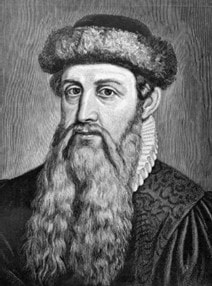
Johann Gutenberg grew up in Mainz, Germany. He devoured books, reading all that his wealthy father ordered. The volumes were outrageously expensive, sometimes costing as much as a farm. Local scribes copied the texts by hand, illuminators decorated the margins, and binders made the covers. Finally the title was stamped into the leather cover by brass punches. It was the punches that suggested an idea to Johann. Why not make separate metal letters and arrange them into words? Why not set up a page and print it using a press?
Johann moved to Strasbourg and set up a secret workshop near an old monastery. Though beset by problems, he toiled for years to get his invention to work. Finally, Johann returned to Mainz where he was assured an income by inheritance.
He set up a printing shop, and in 1450, after 30 years, he was ready to begin. He chose the Bible as his first book. Such a project required he borrow 800 guldens from Johann Fust, but if he wasn’t repaid with interest in five years, Fust demanded, all the equipment and materials would revert to him.
It took Johann two years to set up a workshop. He hired workers, had presses built, and taught laborers to grind and mix ink. Then he was ready to begin printing. Two more years went by, and the invention wasn’t working well. Another year passed, and two months before the Bible was completed, Fust sued. On November 6, 1455 the judge ruled in his favor.
Gutenberg angrily turned over his presses and almost-completed Bibles to Fust. The Bible was reportedly first published on March 13, 1456, and for many years the credit went to Fust and his partner, Peter Schoffer. But after Gutenberg died on February 3, 1469, Schoffer admitted that, after all, Johann Gutenberg had invented printing.
Johann moved to Strasbourg and set up a secret workshop near an old monastery. Though beset by problems, he toiled for years to get his invention to work. Finally, Johann returned to Mainz where he was assured an income by inheritance.
He set up a printing shop, and in 1450, after 30 years, he was ready to begin. He chose the Bible as his first book. Such a project required he borrow 800 guldens from Johann Fust, but if he wasn’t repaid with interest in five years, Fust demanded, all the equipment and materials would revert to him.
It took Johann two years to set up a workshop. He hired workers, had presses built, and taught laborers to grind and mix ink. Then he was ready to begin printing. Two more years went by, and the invention wasn’t working well. Another year passed, and two months before the Bible was completed, Fust sued. On November 6, 1455 the judge ruled in his favor.
Gutenberg angrily turned over his presses and almost-completed Bibles to Fust. The Bible was reportedly first published on March 13, 1456, and for many years the credit went to Fust and his partner, Peter Schoffer. But after Gutenberg died on February 3, 1469, Schoffer admitted that, after all, Johann Gutenberg had invented printing.
---------------------------------------------------------------------------------------
What God has said isn’t only active and alive! It is sharper than any double-edged sword. His word can cut through our spirits and souls and through our joints and marrow, until it discovers the desires and thoughts of our hearts. (Hebrews 4.12)
----------------------------------------------------------------------------------------
What God has said isn’t only active and alive! It is sharper than any double-edged sword. His word can cut through our spirits and souls and through our joints and marrow, until it discovers the desires and thoughts of our hearts. (Hebrews 4.12)
----------------------------------------------------------------------------------------
 RSS Feed
RSS Feed